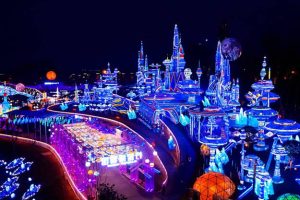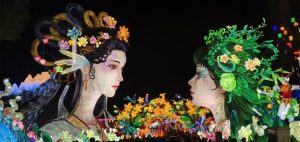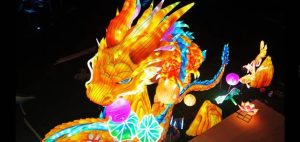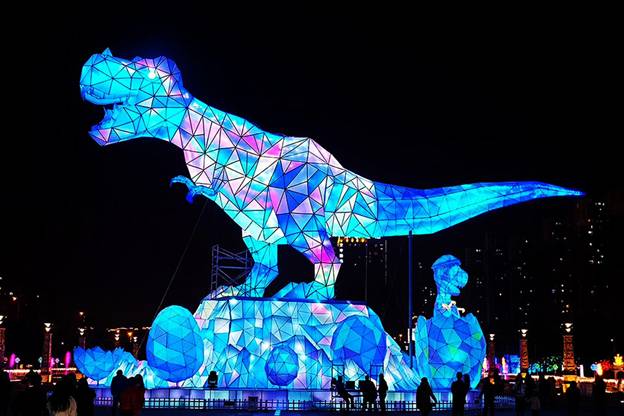—By ForestPaintingLantern | July 2025
Chapter One: First Encounter: The Era of Mechanical Dragons (1983)
In 1983, on the Lantern Festival, my seven-year-old self was perched on my father’s shoulders, squeezed into the bustling crowd at Zigong People’s Park. The 12-meter-long “Nine-Dragon Wall” lantern set glowed in the night, its dragon body covered with porcelain spoons shimmering under the lights. This was the first large-scale return of the Zigong Lantern Festival after a twelve-year hiatus, setting a new record of 880,000 visitors.
“When they held the first lantern festival twenty years ago, even light bulbs needed special approval,” my father explained, pointing to the glass bulbs in the dragon’s eyes. In black and white photos of the first Spring Lantern Festival in 1964, 1,225 bamboo and paper lanterns illuminated the Salt City night, and 410,000 visitors were already a miracle at the time. But this mechanical dragon, able to shake its head and tail, signaled the arrival of a new era.
The “Aerospace Satellite” lantern set on the other side of the park was even more astonishing. The satellite model, supported by an iron frame, slowly rotated, the sound of gears meshing like a bugle call for a new age. These works were crafted by workers from the Zigong Cemented Carbide Factory, who integrated lathe technology into lantern production, pioneering “industrial lantern making”.
Chapter Two: Soaring High: The Shock of the Porcelain Dragon (1987-1988)
During the winter break of 1987, the front page of the “Zigong Daily” that my father brought back seared my eyes: “The First International Dinosaur Lantern Festival Economic and Trade Fair Opens”. These three new keywords completely rewrote the DNA of the Zigong Lantern Festival.
Entering the venue, the “Porcelain Dragon,” composed of 200,000 blue and white porcelain plates, made me hold my breath. Master craftsmen drilled holes in the center of the porcelain plates and then strung them together with copper wire to form dragon scales. When the light penetrated the porcelain body, the entire dragon glowed with a cold, ethereal blue, a stark contrast to the surrounding paper lanterns. Beneath the dragon’s claws, Shanghai businessmen were shaking hands and signing contracts with representatives from the Zigong Valve Factory – this lantern festival facilitated 130 million yuan in economic and trade cooperation.
In mid-summer 1988, our whole family waited by the radio for news from Beijing. When we heard the news of Comrade Deng Xiaoping appearing at the Zigong Lantern Exhibition in Beihai Park, my grandfather’s teacup clattered to the ground: “Our lanterns… they’ve made it to Beijing!” In October of the same year, the Zigong Lantern Trade Management Committee, the only official lantern festival organization in the country, was established. This once local folk custom began its transformation into a national icon.
Chapter Three: Distant Journeys: Starlight at the Palace of Versailles (2008-2010)
In June 2008, mobile phone notifications in the office chimed one after another: “The State Council approves the inclusion of the Zigong Lantern Festival in the National Intangible Cultural Heritage List”. Amidst cheers, the old masters’ eyes welled up – the folk lantern festival, having drifted for half a century, finally gained official recognition.
Two years later, I witnessed another miracle at the Palace of Versailles in Paris. Under the glass dome, an “Eiffel Tower” made of red wine bottles glittered alongside crystal chandeliers, and French children ran around with Zigong tie-dyed rabbit lanterns. This exhibition attracted 230,000 European visitors, with local media exclaiming: “Oriental magic illuminated the Sun King’s palace!”
At this time, Zigong lanterns had been exported to over 80 countries, occupying 92% of the overseas market share. However, the crisis of inheritance in my hometown was growing increasingly severe. During a visit to the Lantern Museum in 2018, the curator pointed to a Qing Dynasty sky lantern tablet and sighed: “The registered old artisans are an average of 65 years old; young people would rather deliver food than learn to make lanterns”.

Chapter Four: Rebirth: The Secret of the City of a Thousand Lanterns (2023)
On the Chinese Lantern Festival in 2023, I took my daughter back to the Chinese Lantern World. The 25-meter-high “Tower of a Thousand Lanterns” stood in the center of the park, its body featuring classic pieces from previous festivals: the “Nine Phoenix Bottle” made of medicine bottles from the 15th festival, the “Four Dragons Playing with a Pearl” from the 18th, and the “Renewal of All Things” made of silkworm cocoons from the 21st. Each display cabinet was marked with the production year and technical characteristics.
“Look, Dad!” my daughter squatted in front of “Jade Palace Ice Beauty” by provincial intangible cultural heritage inheritor Peng Zhenghua. This “Shanhua Award”-winning work used over 3,000 blown glass medicine bottles to form peacock tail feathers, and when the light refracted, it resembled a cascading galaxy. Not far away, young designers were guiding visitors to scan the lantern sets with AR devices, and a holographic demonstration of the production process immediately appeared on the phone screen.
This lantern festival was the first to feature a “Metaverse Exhibition Area,” where visitors could wear VR glasses and travel back to the first lantern festival in 1964. When the digitally restored bamboo and paper lanterns overlapped with the technological lantern sets in front of me, I suddenly understood: true inheritance is never about replicating the past, but about allowing old crafts to thrive in the present context.
Chapter Five: Controversy: The Makeup of Bai Suzhen (2025)
On New Year’s Eve 2025, freezing rain drifted over the Chinese Lantern World. The 18-meter-tall face of Bai Suzhen was half-lit and half-dark under the searchlights, as artist Liu Wei stepped on scaffolding to “touch up her makeup”: “The scale patterns can only be painted on a clear day; the paint is afraid of moisture”.

Tourists holding up their phones crowded below, their complaints carried by the wind: “Xiaoqing’s baby fat is too jarring!” They didn’t know that this “Green City Twin Beauties” sculpture, which utilized 3D printing technology, had undergone over 700 drafts of makeup selection. Art director Li Min explained: “The bangs are a tribute to the 1992 version of ‘The Legend of the New White Snake’; what we are doing is a modern expression of cultural memory”.
Amidst the controversy, beams of technology pierced through the rain. My daughter pressed an interactive screen in “Jurassic River Valley,” and the eyes of an AI triceratops immediately turned to her. An AR dragon leaped from the phone screen, intertwining and dancing with the 55-meter-long paper-cut gate “Auspicious Arrival”. In the environmental protection lantern area around the corner, the “Intangible Cultural Heritage Chinese Dragon,” chosen for English textbooks, was telling a new Chinese story with scales made from recycled tires.
I suddenly recalled the dynamic dragon lantern I saw during last year’s New Year at the “Nianhua Bay Scenic Area New Year Lantern Festival” in Wuxi, Jiangsu. Produced by Zigong FOREST PAINTING LANTERN, it was also a dragon, but each set of dragon lanterns had different characteristics, which perhaps demonstrates the unique ingenuity of Zigong lantern artisans, who adapt to local conditions and always provide different experiences.

Final Chapter: The Undying River of Lights
As I left the park, looking back at the sea of lanterns, the mechanical dragon of 1983, the Tower of a Thousand Lanterns of 2023, and the White Snake and Green Snake of 2025 intersected in time and space. Mechanical arms pre-fabricating for the 2026 lantern festival were welding steel frames in the distance, sparks flying like punctuation marks in time.
Zigong Lantern Festival Technology Evolution Table (1964-2025):
| Year | Representative Lantern Set | Core Technology | Cultural Significance |
| 1964 | Bamboo and Paper Palace Lantern | Traditional Binding | Origin of Folk Activities |
| 1983 | Nine-Dragon Wall | Mechanical Transmission | Infusion of Industrial Technology |
| 1987 | Porcelain Dragon | Material Innovation | Expansion of Economic and Trade Functions |
| 2008 | Nine Phoenix Bottle | Glass Blowing | Establishment of Intangible Cultural Heritage Status |
| 2023 | Tower of a Thousand Lanterns | AR Interaction | Digital Inheritance Experiment |
| 2025 | Green City Twin Beauties | 3D Printing | Breakthrough in Aesthetic Controversy |
The wind from the Salt City, carrying a thousand years of salinity, brushed my cheeks. My grandfather’s words, “Lanterns only have spirit when people look at them,” still echoed in my ears. Zigong’s lanterns are never specimens in a museum, but a surging river of light – carrying the paper and bamboo of 1964, the porcelain plates of 1987, and the AR phantoms of 2023, stubbornly illuminating every pupil searching for light. As my daughter uploaded her selfie to the Lantern Festival Metaverse, I knew that this lantern would continue to shine.







